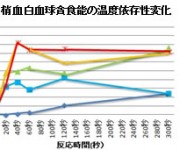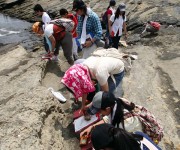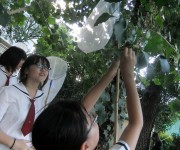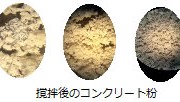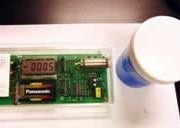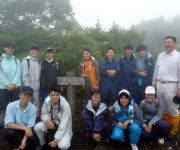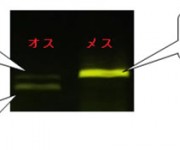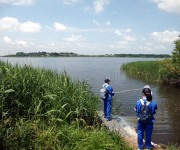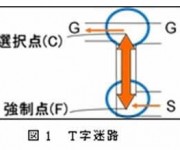- Notice
- Kanto Convention
Tokyo Conference Abstracts: Oral Presentations
2013.12.03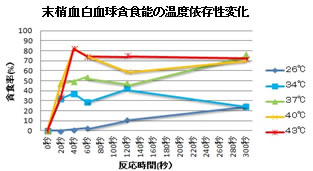
Abstracts of the presentation themes for the 2013 Tokyo Conference are now available.
- Tokyo Conference Oral Presentations
- Tokyo Conference Poster Presentation
- Osaka Conference Oral Presentation
- Osaka Conference Poster Presentation
Science Castle is looking for middle and high school students and teachers who wish to attend the presentations. Not only can you attend the presentations listed below, but you can also communicate directly with the junior high and high school students and teachers involved in the research. Please apply for participation below.
https://s-castle.com/castle2013/join
List of Abstracts of Oral Presentation Themes for Tokyo Conference
In addition to the oral presentations by junior high and high school students, we will receive comments from the junior high and high school teachers who were in charge of teaching the students. Please take advantage of this opportunity to learn about the educational effects of research and the points to keep in mind when conducting research.
Temperature-dependent changes in leukocyte phagocytosis - Fever is the body's defense mechanism - (Japan Women's University Senior High School Science Studio CHIBA Master Course (Chiba University))
Purpose of Activity
By analyzing temperature-dependent changes in leukocyte phagocytosis, we will study the effect of fever on the immune system. The future goal is to find a way to cure colds faster with less burden.
Summary of Activities
The purpose of this study was to examine the effect of fever on the immune system. For this purpose, we constructed an experimental system in which phagocytosis can be determined, and analyzed temperature-dependent changes in peripheral blood leukocyte phagocytosis. The results suggest that heat generation increases the phagocytic activity of leukocytes, enabling rapid elimination of foreign substances that have invaded the body. In addition, they made original discoveries such as finding differences in phagocytic response due to differences in temperature-dependent activation capacity. Furthermore, the possibility that different cells recognize different targets for phagocytosis in multinucleated leukocytes in the peripheral blood was considered. These findings suggest that fever is a defense mechanism of the body that activates the immune system. In the future, they hope to develop a treatment method to cure the common cold quickly with less burden.
Evaluation of mutagenicity of the Sagami River system (Kanagawa Prefectural Kanagawa Sogo Sangyo High School "SSH Theme Research I & II" Team Ames)
Purpose of Activity
Learn about the Sagami River system, the source of Kanagawa Prefecture's tap water, and think about water quality conservation.
Summary of Activities
Periodically, the Ames test as a mutagenicity assessment, mutagenic production potential (MFP), and basic data such as ammonia nitrogen, COD, and residual chlorine are measured. Eight rivers in the water system were surveyed in the initial study, but now we have narrowed it down to four rivers where the Ames test results were positive. The MFP values for these four rivers are also high, suggesting that there may be an influx of mutagenic precursors. Base substitution and frameshift Salmonella were used in each of the tests, and all rivers suggest influx of frameshift material. Currently, we are accumulating data in order to investigate the seasonal variation and basic test items that can be used as indicators for mutagenicity assessment.
Acid rain survey around Sapporo City (Ritsumeikan Keisho Junior High School, Natural Science Department)
Purpose of Activity
In order to investigate air pollution after the nuclear power plant accident, we, the Natural Science Department and Chemistry Group, studied a simple method of collecting "acid rain" and actually investigated "acid rain" around Sapporo City.
Summary of Activities
The Chemistry Group, which was officially launched as a club activity this year, decided to continue the research on "acid rain" that the high school students investigated last year.
In order to increase the number of "acid rain" survey sites, we needed to determine an easy way to collect rain, and we established a simple collection method using 2L plastic bottles.
We investigated acid rain near the cities of Sapporo and Ebetsu, where our school is located, and later expanded the scope of our investigation to Tomakomai City. Tomakomai is home to thermal power plants, paper mills, and other facilities, and is an area where air pollution from fossil fuel combustion is possible.
In this issue, we report on the progress of this research and the activities of the Natural Science Department.
SPP Collaborative Lecture "-Geology of Jogashima-" (SPP participants (1st-3rd grade), Tokyo Metropolitan Mita Senior High School)
Purpose of Activity
Under the guidance of expert faculty members, students will observe and investigate geological phenomena caused by plate movement on a global scale at a familiar site on Jogashima Island in the Miura Peninsula.
Summary of Activities
SPP is a project promoted by the Ministry of Education, Culture, Sports, Science and Technology and supported by the Japan Science and Technology Agency (JST), and our school has been selected for seven consecutive years.
This year, we invited Associate Professor Osamu Takahashi of Tokyo Gakugei University to give a lecture on "Accretionary Geology: The Geology of Jogashima" in cooperation with SPP. Last year, we made geological columnar maps at three sites on Jogashima, and were able to derive certain directions regarding the fold structure, stratigraphy, and changes in the depositional environment. This year, we conducted another field trip to Jogashima and used stereonet analysis based on the strike and dip data of fold structures to infer the direction of the fold axis and plunge angle, as well as the direction of stress in the area.
Experiment of acquisition of conditioned reflex in planaria (Sano Nihon University Senior High School, Specialized Activity, Rika Club)
Purpose of Activity
Planaria ( Dugesia japonica ) brain is said to be an evolutionary whole organism primitive. The purpose of this study was to analyze the function of the planarian brain.
Summary of Activities
As a first step in our investigation of planarian brain function, we considered the acquisition of conditioned reflexes. In this study, we conducted an experiment based on the most famous conditioned reflex experiment, "Pavlov's dog". Planaria are shielded from light and given electrical and optical stimuli at the same time. The planarian showed a contraction response to the electrical stimulus and no response to the light stimulus. Therefore, after giving the two stimuli at the same time, we gave only the light stimulus, which normally does not produce a response, and checked whether or not the planarian responded.
Environmental Initiatives through Biotope (Biotope Committee and Science Club, Tokyo Kasei University Girls' Junior High School)
Purpose of Activity
Investigate the connection between the natural environment and living creatures in urban areas through biotope maintenance activities, surveys of living creatures at the school, and water quality and biological surveys of ponds.
Summary of Activities
To maintain the natural environment on campus, the Biotope Committee has been working to set up a butterfly garden and create insect specimens, in addition to daily maintenance. Last year, for the first time in 10 years, we saw musk swallowtails laying eggs, and a survey of cicada shells revealed certain trends in the timing and location of hatching, depending on the species and whether they are male or female. Meanwhile, the science department is conducting a chemical investigation of the water in the biotope pond using pH and pack tests, as well as an investigation of the organisms. Even in the biotope's artificial ponds, which are relatively closed spaces, we can see diatoms, ciliates and flagellates, and their prey, such as river snails and killifish, as well as the predators of these organisms, such as sand lance and loach.
We have been researching various creatures on campus, focusing on the day biotope. This year we collected 600 cicada shells. What can we learn from them?
Adsorption of Phosphate Ions by Concrete (Chemistry Club, Ibaraki Prefectural Midorioka High School)
Purpose of Activity
Consider the reuse of concrete rubble generated by the Great East Japan Earthquake. Focusing on the adsorption action of concrete, we will study its mechanism.
Summary of Activities
Last year, we attempted to produce silica gel from the components of concrete, but it only resulted in a gel-like substance different from silica gel. Therefore, we wondered if the adsorption action of fine-grained substances found in silica gel could also be found in concrete, and focused our research on the adsorption action of phosphate ions in concrete. In the experiment, the adsorption action of concrete was compared with that of granular materials such as sand and flour using an aqueous solution of sodium dihydrogen phosphate. Next, they studied the most effective method of adsorbing dihydrogen phosphate ions. The adsorption effects of concrete were compared by crushing concrete into powder, passing it through a column filled with concrete powder, and stirring it with concrete powder.
Culture research experiment using human cells (Ishinomaki High School, Miyagi Prefecture, 1st year, Physics Club)
Purpose of Activity
Using human fibroblasts, study the effects of the environment on cells.
Summary of Activities
First, protoplasmic separation was observed using algae and saturated saline solution to investigate the relationship between cells and environmental changes. The results showed that cells change themselves in response to changes in the environment. Next, based on this research, human fibroblasts were given four different materials and cultured overnight. The cells were given undiluted, 10-fold diluted, and 100-fold diluted materials, and the differences between them were also observed. After incubation, dead cells were stained and the number of living cells was counted. The results are summarized in a graph to discuss the differences among the materials and concentrations. We also considered what kind of products these materials could be applied to in the future.
Relationship between ABO blood groups and dopamine-related gene polymorphisms (Toin Gakuen High School, Science and Mathematics Course, 2nd year)
Purpose of Activity
We learn about familiar human genes, what mechanisms cause individual differences, and what experimental manipulations can be used to study genes.
Summary of Activities
We used the PCR method to verify whether the question "Is ABO blood group related to human behavioral patterns?", which is an everyday topic of discussion in Japan, can be explained scientifically. The human ABO blood group gene is located on chromosome 9, near the dopamine β-hydroxylase gene (DBH). This DBH gene is an enzyme gene that converts the neurotransmitter dopamine to norepinephrine, which may influence human behavioral patterns. We hypothesized that these two genes are somewhat linked and passed on to offspring, so we tested for genetic polymorphisms of the DBH gene to see if people with blood type A and those with blood type B showed different tendencies. We also examined polymorphisms of other dopamine-related genes to see if the trends differed by blood type.
Let's look for biodegradable plastics! (Keiai Gakuen High School Science Club)
Purpose of Activity
Efficiently locate decomposing bacteria in strong biodegradable plastics.
Summary of Activities
Our experiment was aimed at finding degrading bacteria for environmentally friendly biodegradable plastics that break down into water and carbon dioxide.
First, in Experiment I, we screened for decomposing bacteria from various environments, including soil and plants. It was found that decomposing bacteria were easily found in grass plants, especially enochlograss. It was also found that the results differed depending on the soil and leaves of the same plant. In Experiment II, a PCR method was used to identify the type of decomposing fungi obtained by the isolation operation, but the amplification of DNA could not be confirmed. This meant that it was necessary to determine whether the decomposing fungi were yeast or bacteria, and that the primers that reacted accordingly were different and different primers had to be used.
-Live or Die: The Journey of the Common Damselfly (Kumon International School Junior & Senior High School Biology Club)
Purpose of Activity
Focusing on creatures that are often found in our daily lives, but that we do not pay much attention to, the exhibition aims to broaden people's understanding of the wonders of living things around us.
Summary of Activities
The Biology Department of Kumon International School captured Usubaki damselflies found throughout Japan and statistically processed data on the sex ratio, body size, and number of mature eggs to uncover the secrets of Usubaki damselfly migration. The results revealed that there are certain areas where Usubaki damselflies tend to congregate, that the sex ratio of captured individuals differs markedly, and that all Usubaki damselflies in the fall season are seen only as immature individuals, which are presumed to die while immature. Although we have not yet reached a conclusion as to why Usubaki damselflies travel, we will continue to try to elucidate the ecology of Usubaki damselflies and unravel the mysteries of their journeys.
Radiation shielding effects of familiar materials (Radiation Research Group, Kohka Gakuen Junior and Senior High School)
Purpose of Activity
They conduct investigations and experiments on radiation and communicate the results to the public so that they have correct knowledge about radiation. They also consider future energy sources, including nuclear power.
Summary of Activities
We, the Radiation Research Group, are an organization that conducts research and experiments on radiation. We have visited research facilities and invited university professors to talk about radiation. We have also conducted fog box experiments and measured radiation levels in the school. The results are presented at the school festival and at school information sessions. This time, we measured the shielding effectiveness of familiar materials in order to develop a safer and easier way to store radioactive materials such as mineral samples and fog box sources at the school. As a result, we found that other materials were highly effective, and we also devised a storage container using such materials. We hope that these results may lead to solutions to current problems.
Gelation of seaweed biomass (3rd grade, Ono Gakuen Girls' Junior High School)
Purpose of Activity
In collaboration with Tokyo University of Agriculture and Technology and Kochi University, the Science Partnership Program was held under the theme of "Learning the cutting edge of biomass research for building a recycling-oriented society of the future.
Summary of Activities
In this activity, we focused on seaweed biomass, which has been attracting attention in recent years due to its rapid growth rate and Japan's environment surrounded by the sea, although the amount of biomass present is small. Gelation experiments were conducted on the polysaccharides alginate (brown algae), agarose (red algae), and carrageenan (red algae), which are the main components of seaweed. As a result, it was confirmed that sodium alginate gels by the addition of calcium chloride, as is known from the production of artificial salmon roe, that agar undergoes a sol-gel transition by heating and cooling, and that the degree of gelation of carrageenan depends on the number of sulfate groups contained in the monosaccharide. The degree of gelation of carrageenan varies depending on the number of sulfate groups in the monosaccharide.
Biodiversity Learned in Camps and Fields: Our Three Years (Shonan Gakuen Junior High School, Science Research Club)
Purpose of Activity
With the aim of contributing to biodiversity conservation, the group conducted observation meetings and biological surveys through camps and field activities to learn about biodiversity in various areas. Here we present an overview of the overall activities.
Summary of Activities
For the above purposes, with a grant from the Japan Science and Technology Agency, we held nature observation meetings in the area near the school, surveyed vegetation along the Shonan coast, participated in a project to restore the rare Hamaboufu plant, restored a valley field in a satoyama, observed biodiversity in the Akaya Forest in Minakami Town, Gunma Prefecture, and conducted a survey and follow-up of beech and konara oak seedlings to restore a broad-leaved forest. In addition, we observed large winter birds such as geese in Izunuma swamp in Kurihara City, Miyagi Prefecture, and conducted an ecological survey of aquatic organisms.
During the nature observation, I learned that there are many interesting creatures in Shonan and the Miura Peninsula. We also learned that a great deal of work is required to restore and maintain satoyama. In addition, at the camp, we learned about the preciousness of rich nature and the impact of invasive alien species.
They have "biodiversity" that came into view as a result of learning about nature around them and then being exposed to the richness of nature. The perspective based on experience is noteworthy.
Research on the chemical cycle of polylactic acid (1st year student, Biology Club Chemistry Team, Shizuoka Prefectural Gotemba Minami High School)
Purpose of Activity
We focused on rice water that is discarded as a raw material derived from natural resources with little fear of depletion, and explored the possibility of biodegradable plastics by polymerizing lactic acid through lactic acid fermentation.
Summary of Activities
We wanted to make effective use of food waste in order to solve serious problems such as the current social issue of increasing waste discharge. Focusing on the rice water that is discarded from rice, a staple food, we attempted lactic acid fermentation using the large amount of glucose, sucrose, lactic acid bacteria, and yeast bacteria contained in it. Simple anaerobic conditions were created using plastic bottles and incubated in a 37°C thermostatic incubator for 6 days. Twenty-four hours after the start of incubation, a sharp decrease in pH was observed. The obtained culture medium was analyzed by HPLC and determined to be lactic acid. Attempts were made to isolate lactic acid from the culture medium obtained by the esterification method, but simple distillation and dehydration equipment were unable to isolate it. We are currently investigating a method to isolate pure lactic acid from the culture medium.
Self-digestion of planaria" (Planaria Group, Tsuru High School, Yamanashi Prefectural Tsuru High School)
Purpose of Activity
The causes and mechanisms of planarian self-digestion will be investigated based on changes in mortality from amputation experiments.
Summary of Activities
Planaria, which are invulnerable to females, die when amputated after feeding. This is thought to be because they are self-digested by digestive enzymes in the gastrointestinal tract that permeate throughout the body. We are interested in how this phenomenon of self-digestion occurs.
In the amputation experiment, mortality decreased on the fourth day after amputation. Along with the results of collection and rearing, thermal disintegration was presented, and future experimental strategies were discussed.
How to see the next generation of organisms: The sex of killifish from the viewpoint of DNA (Tokyo University of Agriculture First High School, Biology Department, DNA Team)
Purpose of Activity
We will seek a new way of looking at organisms from a visual point of view, which is becoming increasingly difficult, and explore ways of examining them using DNA. First, we will use DNA analysis to identify the sexes of killifish.
Summary of Activities
The purpose of the experiment is to determine the sex of medaka fish. Although it is possible to visually identify sexes, it is not reliable. Therefore, DNA testing will be used to determine the sexes. The sex chromosomes contain two sex-determining genes, "DMRT1" and "DMY," which function as sex chromosomes when expressed. By using these genes, it is possible to accurately identify the sexes of medaka fish by PCR and electrophoresis. In the experiment, PCR is performed using primers that act on the medaka sex-determination genes "DMRT1" and "DMY" to ensure that sex can be identified. Afterwards, the sequence is decoded using the dideoxy method and checked against existing databases to confirm that the PCR has been successfully performed.
The Beginning of Radio Observation of Meteors (Volunteer Radio Observation Group of Meteors, Tokyo Metropolitan Fuchu Technical High School)
Purpose of Activity
Observations are made 24 hours a day, 365 days a year to elucidate meteor showers.
Summary of Activities
The data is tabulated every few days and graphed as a whole. The data is also tabulated for each meteor shower.
On December 8 (Universal Time), the phantom Andromeda meteor shower was captured in Canada. We wonder if it was captured at Fuchu Kogyo! The Geminids meteor shower, which is usually vividly active every year, is also noteworthy for observation.
Green Beetle Culture and Product Development (Hiratsuka Agricultural High School, Kanagawa Prefecture, Food Science Department, 3rd year, Class C, Green Beetle Group)
Purpose of Activity
Researching the cultivation methods of the much talked-about Green Beetle, as well as its utilization methods.
Summary of Activities
As an alternative to integrated learning time, agricultural high schools offer a three-credit course called "Problem Research. Using this time, we have been conducting research in three steps: 1) studying the culture conditions of Euglena gracilis, which was distributed by the National Institute for Environmental Studies; 2) developing products using dried powder distributed by Euglena Co. We will propose bright green cookies and baked goods.
Ushiku's Nature IX: Message from Creatures of Ushiku Marsh (Ushiku Municipal Ushiku Daisan Junior High School Science Club)
Purpose of Activity
With the goal of "restoring Ushiku-numa," the research was conducted to explore the current status of Ushiku-numa through surveys of water quality, vegetation, dragonfly ecology, and birds, and to use the results as a springboard for future environmental improvements in Ushiku-numa.
Summary of Activities
For the past nine years, our school's Science Department has conducted surveys of the environment around Ushiku Marsh, located just southwest of the school, including water quality, vegetation, dragonflies, and birds. This year, we continued to conduct surveys around Ushiku San-chu Junior High School, Ushiku Marsh, and the surrounding rivers, focusing on field observations and considering the connection between each creature and its environment.
Although at first glance Ushiku-numa may look dirty, many creatures live there, changing their habitats as the environment changes. 9 years of research has shown that it is important for the "restoration of Ushiku-numa" to learn about the many creatures that live there and to think about their symbiosis with people.
Alternate turnover reaction in the Japanese beetle, Pseudorasbora japonica (2nd-year student, SSH Exploratory Biology Course, Iwaki Senior High School, Fukushima, Japan)
Purpose of Activity
Investigate the alternating turnover of the cockatoo beetle.
Summary of Activities
The alternating turnover response is the tendency of an animal to change its direction of turn in an alternating manner from right to left to right to left when it moves. In a study of alternating turnover in the Japanese beetle, a T-maze with a forced turnaround point (F) and a choice point (C) was used, where the subject was forced to turn in one direction or the other. (Watanabe and Iwata, 1956). However, there is a report that alternating inversion is observed even when the distance between FCs is 16 cm (Kawai, 2011). Therefore, we investigated whether alternating inversion is observed at 16 cm FC or longer. We also investigated the mechanism by which this alternating inversion occurs.
Research on composting with earthworms: Waste if thrown away, resource if used (Fukushima Prefectural Aizu Gakuho Junior & Senior High School, SSH Exploration Club, 1st Year Earthworm Group)
Purpose of Activity
Organic farmers in Fukushima Prefecture are having difficulty obtaining safe compost due to the recent nuclear accident. We wanted to help in the recovery effort by using earthworms to make compost from food waste.
Summary of Activities
We will conduct a survey of earthworms living in Aizu, where we live, to select and study suitable earthworms for making compost by worm composting. As raw materials for composting, cut vegetables generated in large quantities at supermarkets, etc. will be used.
This year, earthworms inhabiting Aizu were collected for species identification. Identification by morphology was confirmed by DNA analysis to confirm the reliability of morphological identification and the distribution of each species. In addition, soil composition (P, N, pH, and granular structure) was also investigated, with the aim of selecting earthworms suitable for decomposing cut vegetables and creating compost based on the results.
Ishigaki Discovery Science Camp Environmental Research Report (Ishigaki Island Environmental Research Team)"]
Purpose of Activity
The nature of Ishigaki Island, with its coral reef sea and mangrove forests, is changing day by day. In this study, we consider the future of the island by researching the island's environment and lifestyle with local people.
Summary of Activities
In this presentation, we report on the results of a four-day visit to Ishigaki Island by junior and senior high school students from the Kanto and Kansai regions, where they experienced and studied the island's nature, lifestyle, and culture. In vegetation and water quality surveys of mangrove forests, the students discovered changes in the vegetation in the mangrove forests and the effects of nature on people's lives. In addition, tofu-making and brown sugar-making experiments conducted by local people allowed us to elucidate the traditional wisdom that is utilized in daily life from a scientific perspective. Through these surveys and research, we will reveal changes in nature and the wisdom of traditional lifestyles that even the residents of Ishigaki Island were unaware of, and propose ways to protect the nature and traditional techniques of Ishigaki Island, as well as new attractions.
Please register as soon as possible!
 If you find a topic that interests you, please come to the venue to attend the presentation. We would appreciate your cooperation in registering as early as possible in order to prepare the abstract book and other materials to be distributed on the day of the conference.
If you find a topic that interests you, please come to the venue to attend the presentation. We would appreciate your cooperation in registering as early as possible in order to prepare the abstract book and other materials to be distributed on the day of the conference.
Back to Top

